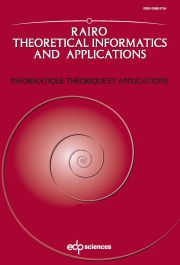Article contents
Non-Looping String Rewriting
Published online by Cambridge University Press: 15 August 2002
Abstract
String rewriting reductions of the form $t\to_R^+ utv$  , called loops, are the most frequent cause of infinite reductions (non-termination). Regarded as a model of computation, infinite reductions are unwanted whence their static detection is important. There are string rewriting systems which admit infinite reductions although they admit no loops. Their non-termination is particularly difficult to uncover. We present a few necessary conditions for the existence of loops, and thus establish a means to recognize the difficult case. We show in detail four relevant criteria: (i) the existence of loops is characterized by the existence of looping forward closures; (ii) dummy elimination, a non-termination preserving transformation method, also preserves the existence of loops; (iii) dummy introduction, a transformation method that supports subsequent dummy elimination, likewise preserves loops; (iv) bordered systems can be reduced to smaller systems on a larger alphabet, preserving the existence and the non-existence of loops. We illustrate the power of the four methods by giving a two-rule string rewriting system over a two-letter alphabet which admits an infinite reduction but no loop. So far, the least known such system had three rules.
, called loops, are the most frequent cause of infinite reductions (non-termination). Regarded as a model of computation, infinite reductions are unwanted whence their static detection is important. There are string rewriting systems which admit infinite reductions although they admit no loops. Their non-termination is particularly difficult to uncover. We present a few necessary conditions for the existence of loops, and thus establish a means to recognize the difficult case. We show in detail four relevant criteria: (i) the existence of loops is characterized by the existence of looping forward closures; (ii) dummy elimination, a non-termination preserving transformation method, also preserves the existence of loops; (iii) dummy introduction, a transformation method that supports subsequent dummy elimination, likewise preserves loops; (iv) bordered systems can be reduced to smaller systems on a larger alphabet, preserving the existence and the non-existence of loops. We illustrate the power of the four methods by giving a two-rule string rewriting system over a two-letter alphabet which admits an infinite reduction but no loop. So far, the least known such system had three rules.
Keywords
- Type
- Research Article
- Information
- Copyright
- © EDP Sciences, 1999
References
- 11
- Cited by


